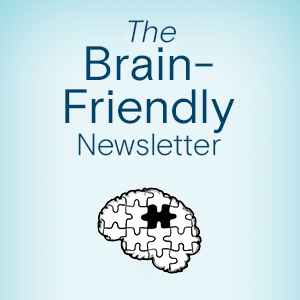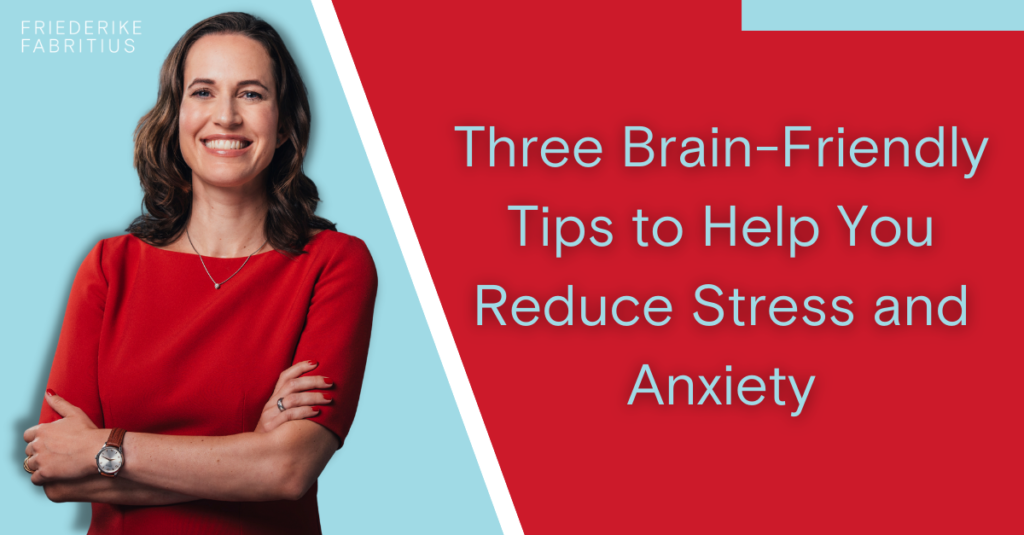Three Brain-Friendly Tips to Help You Reduce Stress and Anxiety

The Brain-Friendly Newsletter
When it comes to managing stress and anxiety, the idea that the body can control the mind seems alien to many of us. But sometimes, the most effective route to your brain is through your body. If you want to improve your mental health, a great place to start is with your physical self check out the first installment of my new monthly newsletter! Keep reading to find out three simple, straightforward physical things you can start on right away to improve your mood and mindset. And be sure to subscribe on LinkedIn to stay up to date with The Brain-Friendly Newsletter, full of new brain-friendly tips every month!

Three Brain-Friendly Tips to Help You Reduce Stress and Anxiety
Would you believe me if I told you that you have a secret weapon in your bathroom to scientifically reduce your stress and anxiety? What if I told you it’s your bathtub?
Almost every day, I take an ice bath or cold shower – It makes me feel great! The release of norepinephrine from our adrenal glands when prompted by the cold activates the brain’s energizing dopamine system. Cold showers and ice baths reduce anxiety, boost energy and immunity, improve mood, and foster longevity.
One study found a 530 percent increase in norepinephrine and a 250 percent increase in dopamine in subjects who were immersed in chilly water for just a few minutes1. But how can something so obviously physical affect our moods?
Most of my career as a neuroscientist has seen me focusing my attention on questions like this. The pathway from the brain to the body is not a one-way street, but rather, it’s a two-way road. That’s to say that the two are intimately connected and if you want to improve your mental health, the easiest way to start is with your physical self.
During a recent keynote address I was delivering at the meeting of a large multinational company, I noticed that the audience seemed amused or intrigued when I mentioned my ice bath secret. But were they convinced?
I decided to take an informal poll: how many people used cold showers or ice baths to combat stress?
As I peered out among the crowd, I saw quite a few hands go up. Then I looked down at the first row, where the management board were all seated.
Every single one had a hand raised. That can’t be only a coincidence!
But, maybe ice baths aren’t for everybody (even though I do still think you should try it at least a few times). There are other ways we can use our bodies to reduce stress and anxiety. Here are two additional examples, no ice required!
Sports
Exercise is the undisputed champion when it comes to natural stress busters.
If exercising cost a fortune, people would flock to it as the latest fad. It regulates the release of serotonin, dopamine, and norepinephrine, and because it also does a great job of flushing out built-up stress hormones, it has a measurable impact on anxiety and depression. Something so simple and effective, but often it’s routinely ignored or even resisted.
Try adding just a small amount of physical activity to your day and see what it does.
Even if you’re an exercise skeptic or feel you’re in no condition to develop a running routine, try something gentle like jogging for two minutes, resting for two minutes, and then jogging for two more. Or maybe turn your meetings into walking meetings and get the added mood-boosting benefits of social connection.
You may be surprised at how fast you feel a change not only physically, but mentally as well.
Snacks
Snacks don’t deserve their bad rap! Well, maybe if we’re talking pork rinds, potato chips, or jellybeans, the notoriety is well deserved. But if by “snacks” we mean nuts, fruits, and yes, even chocolate (as long as it’s dark), bring ‘em on!
Studies have found that some foods (such as apples, blackberries, and dark chocolate) can even cause an increase in our production of anandamide, a neurotransmitter that binds to the same receptors as THC, the feel-good psychoactive compound found in marijuana.2
Often, we are creatures of habit and opportunity, so if you want to eat healthy, don’t allow unhealthy food to enter your home! If you peer into your refrigerator and the naughtiest item you can find is a ripe, juicy apple, then that’s what you’ll eat – it’s that simple.
I hope that these techniques will help you to reduce stress and anxiety and convince you just how deep the connection is between mental and physical health. There’s plenty of evidence to support it – a body of evidence, in fact.
Want more brain-friendly tips? Check out my upcoming book, The Brain-Friendly Workplace: Why Talented People Quit and How to Get Them to Stay.
And if your friends or colleagues would benefit from monthly brain-friendly tips, please click here to share this newsletter with them.
Sources:
- P. Šrámek et al., “Human Physiological Responses to Immersion into Water of Different Temperatures,” European Journal of Applied Physiology 81, no. 5 (March 2000): 436–42, https://doi.org/10.1007/s004210050065.Temperatures,” European Journal of Applied Physiology 81, no. 5 (March 2000): 436–42, https://doi.org/10.1007/s004210050065.
- BFW, 65